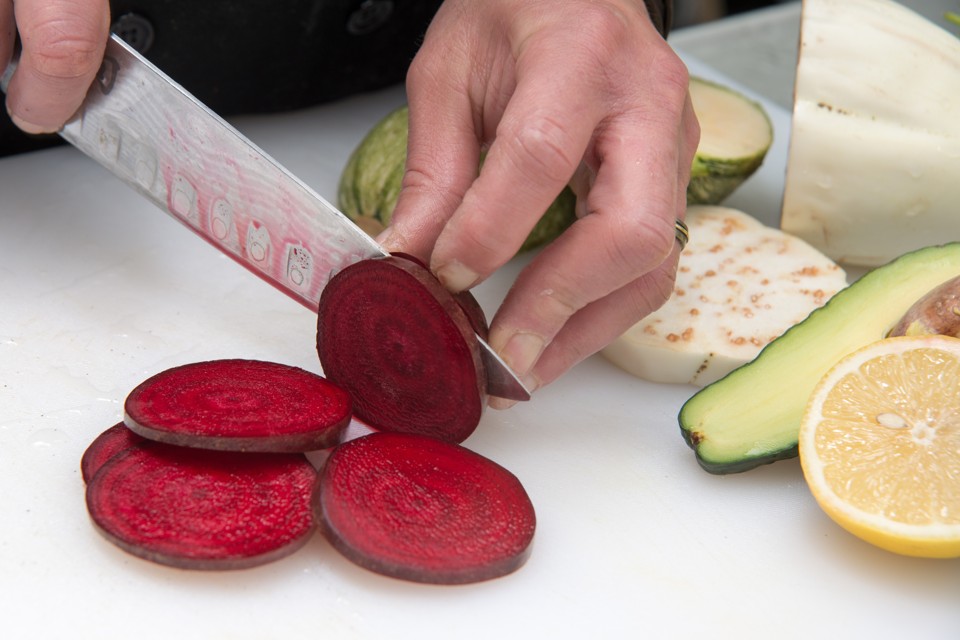Mazourek, who had never thought much about how his foods would be cooked once they left the farm, asked Barber what he had done to prepare the Honeynut. After the chef explained his technique, he asked a question of his own: The Honeynut didn’t store as well as other types of winter squash, Barber said, which meant the restaurant couldn’t keep them on the menu very long. Was it possible to develop a squash with all of the flavor, but a longer shelf life? There in the kitchen, Mazourek launched into an explanation of his classical breeding techniques, a conversation that quickly became a back-and-forth about what chefs needed and what plant scientists could provide.
Since then, the two men have continued their mutual education, working together to conceptualize and develop new fruits and vegetables. “It’s this chain reaction of eureka moments,” Mazourek says. “‘You want to do that? I can do this.’ ‘You can do that? Let’s take it this way.’”
Mazourek is one of only a handful university-based researchers in the United States who develops new organic fruits or vegetables. Most of his colleagues, he says, focus primarily on traits like storability and shipability, with flavor further down on the list of priorities.
The diversity that can be achieved through classical plant breeding is as impressive as anything food scientists can dream up in a laboratory. For example, Jim Myers, a professor of vegetable breeding and genetics at Oregon State University, created the Indigo, a purple-shouldered variety of tomato with higher levels of antioxidants. Both he and Cornell’s Mazourek have developed habañero peppers that have all the flavor of the original, but none of the heat.
While working with several organic farmers to find a source for disease-resistant potato plants in 2008, Selman recalls, she came across two plant breeders who said they’d developed a new variety that was easy for farmers to grow, produced a lot of tubers, and was less likely to contract common diseases. But when Selman asked about the potatoes’ flavor, they told her, “They taste terrible.”
Why would anyone develop new edibles that are barely edible? The short answer is that priorities in the food system changed after World War II: Grocery stores and large-scale industrial farms wanted foods that looked uniform, could be shipped long distances, and stayed fresh in storage. They wanted plants that produced a high volume of food and could be harvested by machine.
Today, consumer tastes are forcing a change, as more people value food that’s organic or locally sourced—but the system for supplying fruits and vegetables that meet this changing demand has been slow to catch up.
These showcases expose breeders to the innovative ways chefs can cook with their foods. One hit from this year’s showcase, for example, was an apple-parsley granita served over buttermilk mousse, made by the chef Nora Antene from the restaurant Le Pigeon. Last year, the same chef had made a popular habañero-orange sherbet.
“It totally blew my mind,” says Myers. “That’s something I would have never thought you could do with these items.”
With the Culinary Breeding Network, he continues, “there’s this cross-fertilization with breeders and chefs. I take that information back to the field and think about what I need to do in terms of breeding. And I think the chefs are excited to get these novel things to work with.”
Joshua McFadden, the executive chef and a partner at the Portland restaurant Ava Gene’s, is one of them. A former farmer and an alumnus of Blue Hill, he’s currently working with Ayers Creek Farm to help them refine their winter melons—he and his staff save the seeds from the tastiest fruits they use and send them back to Ayers Creek for planting.
“I want flavorful food,” McFadden says. “There’s nothing more important than flavor. If you’re breeding for flavor, a lot of the crops that were lost due to scalability and industrialization will come back.”

